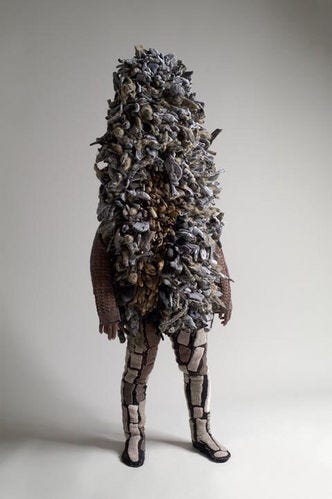Yvonne Singer just sent this image in response to all the dazzle:

dazzle, sub fusc:
This is Nick Cave, not the singer, but the artist from Missouri who was with Alvin Ailey American Dance Theater and then director of the fashion program at the Art Institute of Chicago. Above, is a Soundsuit. Soundsuits' references are wide and deep, they are sculptures, costumes, installations. They are assemblages, they make sounds, they refer historically to various African ceremonial garments. They appear in performances and art galleries.
And here is a brief and early introduction:
I first came across Nick Cave’s soundsuits in 2009 with an exhibition at UCLA’s Fowler Museum which the curator’s statement squarely placed him and his work as material culture of ‘diverse peoples’, the mandate of the Fowler. At the time, I found a review by Christine Isé, ‘The Soundsuits of Nick Cave: Contemporary Art or Material Culture?’, which, looking back on now seems overly worried about the fine epistemologies of art as material culture, or art, or outsider art, or folk art, or as costume, a discussion so arcane today as to be irrelevant. However, I had long seen architecture as material culture, so I was interested in this discussion.
2009: the first iPhone in 2007, the heralded post-racialism of the election of Obama in 2008, social media was gathering steam with YouTube (2005), Twitter (2006), Instagram (2010); before the founding of Black Lives Matter in 2013. Things have changed muchly.
Isé’s review appeared in Bad at Sports, a still very active art website of essays and podcasts, founded in Chicago in 2005 and self-described as acting as ‘a curious investigator, an archivist, oral historian, and occasionally as a provocateur. …We represent artists and their art world through an archive that is text, audio, physical, ephemeral, historical, and constantly evolving through ongoing and unique projects.’
Not the New York Times then. or Art in America.
Nick Cave’s Forothermore, a retrospective of all his work not just soundsuits, is currently at the Guggenheim. The New York Times review of it ‘A Nick Cave Survey: Brutality, Bedazzled’ by Max Lakin is fully immersed in Cave’s identity as the driver of his work. This is new, this critical inclusion of, right up front, Cave’s response to the beating of Rodney King in 1992 – his ‘inflammatory response’ to racial profiling and the violence meted out, still, to the black body.
Soundsuits are both camouflage and a kind of armour: the body is made larger, its outline is made ambiguous, they look like ghillie suits, they refer to a long history of African ceremonial dress. They move, they dance, they are released by the body within. They are made from detritus, each broken plastic cup, each tool without a handle, each unravelled garment thrown away, picked up by Cave to construct a new being.
What I take from this kind of review, no longer formal or epistemological art critique, is the influence of social media, free blogs, the original promise of the internet as an array of diverse voices, previously unheard and walled off from orthodoxy. Things have since been talked about, written and discussed in terms discontinuous with the history of art. One could, if one was so disposed, cite a list of precedents to Cave: the gender queering of Duchamp, the fragmenting of form of the Cubists, collage, surrealism, Warholic performance, installations – of course these are all there, but they don’t seem, any more, the most important thing about Nick Cave’s work.
Gloria Steinem has said it takes about a hundred years for a social change to really become an embedded part of the social fabric. Second wave feminism is about 50 years old and so, no, we are not in a post-feminist era, we still have 50 years of feminist struggle ahead. The civil rights movement in the USA of the 1950s and 1960s, just 60-70 years old. Fifteen years ago I was starting to find work such as Nick Cave’s, but also Theaster Gates and Tyree Guyton, tentatively entering contemporary art discourse; not yet post-racial but allowed to take its place within the discourse, and that was new.
What has happened in the 2020s is that the discourse seems fragmented, unfocussed, wildly multidisciplinary, a correction to rigid orthodoxy and the beginning of something more inventive, more responsive, more of a piece with such inventive, responsive, historically complex and politically intense work.






I suppose it is because the traditions of art writing come with such baggage, earned, no doubt, but distracting. The same for architecture. So I've tried to reconfigure the discussions of things in the art and architecture world as cultural objects that can float more freely. This allows legitimate discussion of politics, anger, pain, joy not as personal qualities, but as markers of the culture the person – the artist or architect – finds themselves in.
There is so much we are not allowed to discuss, especially in architectural critique.
I love that you avoid previous labels and describe/accept Material Culture as an apt grouping: performance, art object, assemblage, sound, costume.